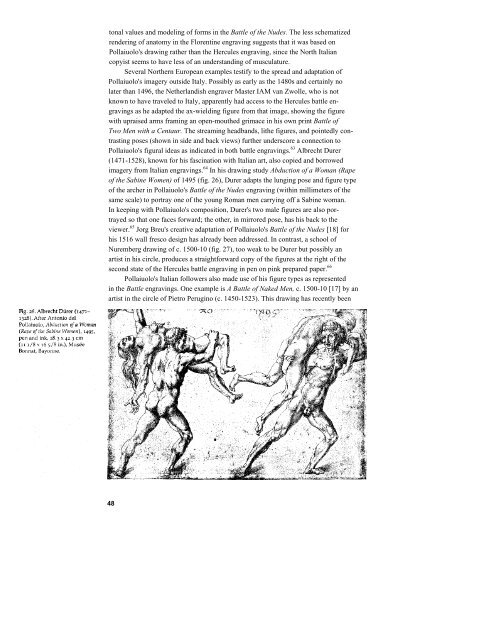Battle of the Nudes
Battle of the Nudes
Battle of the Nudes
You also want an ePaper? Increase the reach of your titles
YUMPU automatically turns print PDFs into web optimized ePapers that Google loves.
tonal values and modeling <strong>of</strong> forms in <strong>the</strong> <strong>Battle</strong> <strong>of</strong> <strong>the</strong> <strong>Nudes</strong>. The less schematized<br />
rendering <strong>of</strong> anatomy in <strong>the</strong> Florentine engraving suggests that it was based on<br />
Pollaiuolo's drawing ra<strong>the</strong>r than <strong>the</strong> Hercules engraving, since <strong>the</strong> North Italian<br />
copyist seems to have less <strong>of</strong> an understanding <strong>of</strong> musculature.<br />
Several Nor<strong>the</strong>rn European examples testify to <strong>the</strong> spread and adaptation <strong>of</strong><br />
Pollaiuolo's imagery outside Italy. Possibly as early as <strong>the</strong> 1480s and certainly no<br />
later than 1496, <strong>the</strong> Ne<strong>the</strong>rlandish engraver Master IAM van Zwolle, who is not<br />
known to have traveled to Italy, apparently had access to <strong>the</strong> Hercules battle en-<br />
gravings as he adapted <strong>the</strong> ax-wielding figure from that image, showing <strong>the</strong> figure<br />
with upraised arms framing an open-mou<strong>the</strong>d grimace in his own print <strong>Battle</strong> <strong>of</strong><br />
Two Men with a Centaur. The streaming headbands, li<strong>the</strong> figures, and pointedly con-<br />
trasting poses (shown in side and back views) fur<strong>the</strong>r underscore a connection to<br />
Pollaiuolo's figural ideas as indicated in both battle engravings. 63 Albrecht Durer<br />
(1471-1528), known for his fascination with Italian art, also copied and borrowed<br />
imagery from Italian engravings. 64 In his drawing study Abduction <strong>of</strong> a Woman (Rape<br />
<strong>of</strong> <strong>the</strong> Sabine Women) <strong>of</strong> 1495 (fig. 26), Durer adapts <strong>the</strong> lunging pose and figure type<br />
<strong>of</strong> <strong>the</strong> archer in Pollaiuolo's <strong>Battle</strong> <strong>of</strong> <strong>the</strong> <strong>Nudes</strong> engraving (within millimeters <strong>of</strong> <strong>the</strong><br />
same scale) to portray one <strong>of</strong> <strong>the</strong> young Roman men carrying <strong>of</strong>f a Sabine woman.<br />
In keeping with Pollaiuolo's composition, Durer's two male figures are also por-<br />
trayed so that one faces forward; <strong>the</strong> o<strong>the</strong>r, in mirrored pose, has his back to <strong>the</strong><br />
viewer. 65 Jorg Breu's creative adaptation <strong>of</strong> Pollaiuolo's <strong>Battle</strong> <strong>of</strong> <strong>the</strong> <strong>Nudes</strong> [18] for<br />
his 1516 wall fresco design has already been addressed. In contrast, a school <strong>of</strong><br />
Nuremberg drawing <strong>of</strong> c. 1500-10 (fig. 27), too weak to be Durer but possibly an<br />
artist in his circle, produces a straightforward copy <strong>of</strong> <strong>the</strong> figures at <strong>the</strong> right <strong>of</strong> <strong>the</strong><br />
second state <strong>of</strong> <strong>the</strong> Hercules battle engraving in pen on pink prepared paper. 66<br />
Pollaiuolo's Italian followers also made use <strong>of</strong> his figure types as represented<br />
in <strong>the</strong> <strong>Battle</strong> engravings. One example is A <strong>Battle</strong> <strong>of</strong> Naked Men, c. 1500-10 [17] by an<br />
artist in <strong>the</strong> circle <strong>of</strong> Pietro Perugino (c. 1450-1523). This drawing has recently been<br />
48
















